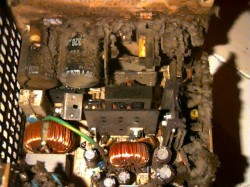Approaches of Attack
There is one step that you should not skip when cleaning your computer. Turn it off and unplug it. This will ensure that you don’t ruin your hardware by accidentally shorting it somehow. Note that the BIOS battery contains a small charge, so cleaning with water is still not entirely safe.
Before you start delving into your computer’s innards, you will need to ground yourself. If you don’t have a grounding wrist strap, you can instead touch an electrically grounded household item, such as a metal water faucet, or a metal lamp. If you are on a carpeted floor, do not move from that spot. If you do, you will need to ground yourself again because shuffling around on a carpet builds up a static charge. Static electricity can cause as much havoc as water can.
After you are all set, grab the vacuum cleaner and suck up the extraneous dust bunnies that are scurrying around in the case. Next, attack the case with the air can and pay special attention to the power supply fan(s), the CPU’s HSF (Heatsink and Fan unit), any other smaller HSFs or heatsinks, and finally the rear fan (if there is one). For the large HSF on the CPU, you may want to unscrew the fan from the heatsink and use the air can to blow out the dust from all the small slots. When you put the fan back, make sure it’s facing the same way it was when you took it off (it should be blowing down on the heatsink). Also make sure that you screw it tight, otherwise it will vibrate and make noise. Usually, the easiest way to handle fans is to hold one of the blades with a finger, jam it with a writing utensil, or jam it with a straw. This is so when you directly blast air on the fan, it will prevent the fan from spinning at high speed because of the forced air, which potentially causes damage to the fan motor or motor bearings. That can only lead to a noisy and faulty fan. Once you have made the fan blades stationary, let it have a few blasts of air, and follow-up with a cleaning with a Q-Tip to get at anything that was missed. Whenever possible, while using the air can, try to shoot the dust out of the case, rather than back in. It saves time so you don’t have to keep blowing out the same area over and over again because of dust finding its way back to the same place over and over again.

Here's an example of a case fan that could use a good cleaning.
The next major component you should take time to clean is the power supply. When your computer is on, it sucks warm air from within the case and forces it out the back, picking up dust along the way. Take the air can and blow out the power supply from within the case and try to force the dust out though the back of the case. Be careful not to blast the fans directly if you can’t make the blades stationary, so as not to damage them. It’s amazing how much dust can be expelled from this one computer component, so make sure you do a thorough job.

A fan grill clogged with dust can impede air flow, resulting in hot air remaining in the case, rather than being expelled out.
If there is a pretty good layer of dust over everything, you may want to remove the RAM, PCI cards and AGP card for a cleaning (if you have the latter two). Try to hold them on the edges, rather than griping the gold contacts or circuit board. Blow them off with the air can and don’t forget to blow out the slots on the motherboard too. Take a cloth, dampen it with isopropyl alcohol and wipe off the contacts on the RAM, PCI cards and AGP card. That should take care of any contact problems; past or future.
Removing the drives for a cleaning is also a good idea; especially the hard drive(s). Blow off the circuit board with an air can and wipe down the rest of the drive with a cloth dampened with isopropyl alcohol. One thing you do not want to do to the drives with removable media is take the air can and blow into the drive slot. If there’s enough dust in there, it’s a good possibility that the drive would malfunction after that.
If you see any other surfaces that need to be wiped free of dust and dirt, use a cloth dampened with isopropyl alcohol. Never apply the liquid to any parts directly. That could cause more harm than good. Make sure you keep folding the cloth over to a clean side as one side becomes laden with dust and dirt. You don’t want to wipe down your hardware with a dirty cloth, for it doesn’t do a whole lot of good.
Now, for laptops, there isn’t a whole lot you can do since everything is enclosed. First, you can clean off the LCD screen, keyboard and touch pad with isopropyl alcohol. If the keyboard is really bad, you can pop off the keys and blow out the dust and crumbs that may have gotten in there. The fan grills can also be blown out.





 AdamTheTech.com and respective content is Copyright 2003-2025.
AdamTheTech.com and respective content is Copyright 2003-2025.